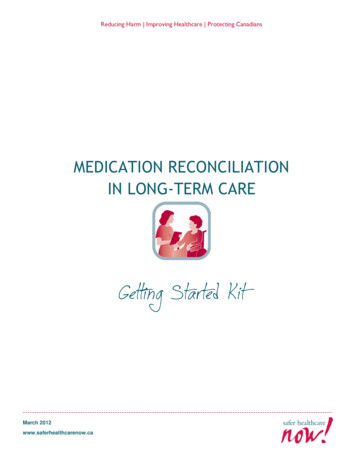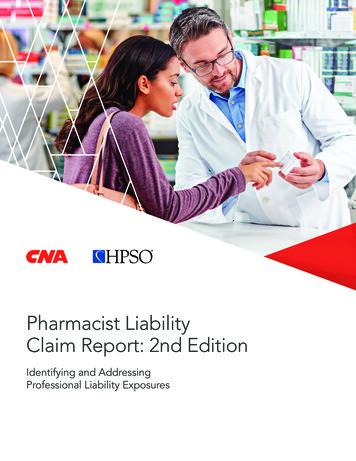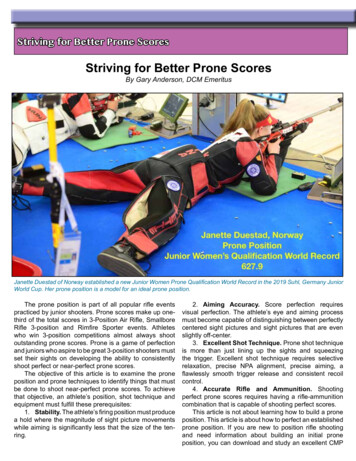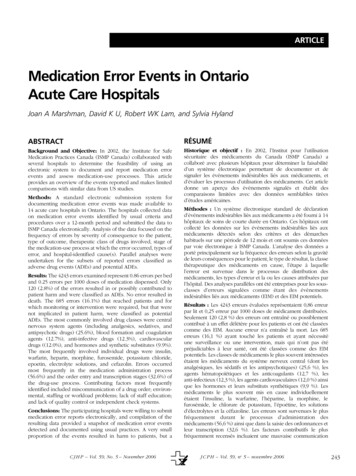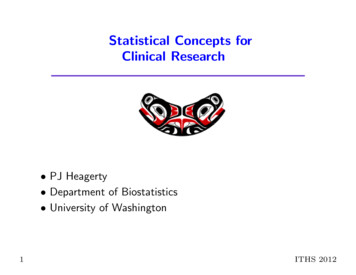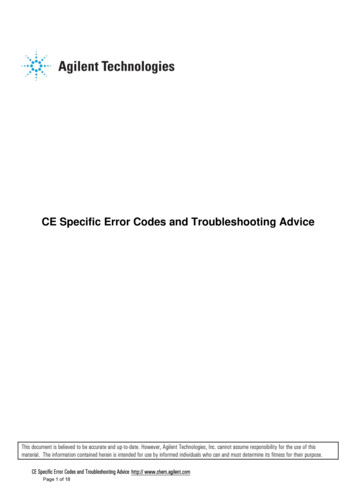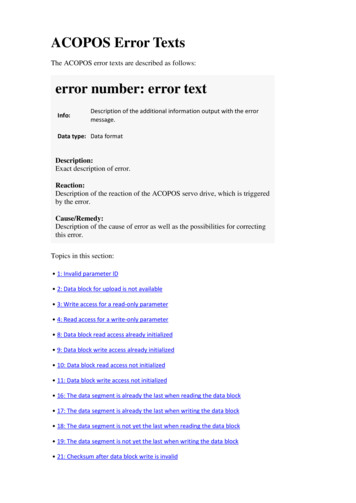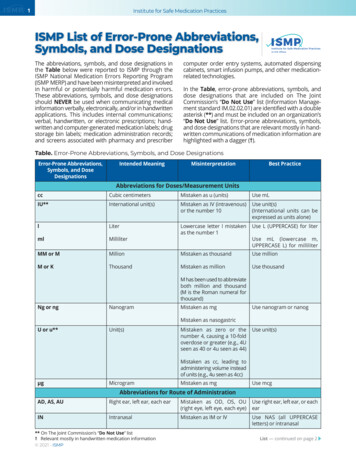
Transcription
1Institute for Safe Medication PracticesISMP List of Error-Prone Abbreviations,Symbols, and Dose DesignationsThe abbreviations, symbols, and dose designations inthe Table below were reported to ISMP through theISMP National Medication Errors Reporting Program(ISMP MERP) and have been misinterpreted and involvedin harmful or potentially harmful medication errors.These abbreviations, symbols, and dose designationsshould NEVER be used when communicating medicalinformation verbally, electronically, and/or in handwrittenapplications. This includes internal communications;verbal, handwritten, or electronic prescriptions; handwritten and computer-generated medication labels; drugstorage bin labels; medication administration records;and screens associated with pharmacy and prescribercomputer order entry systems, automated dispensingcabinets, smart infusion pumps, and other medicationrelated technologies.In the Table, error-prone abbreviations, symbols, anddose designations that are included on The JointCommission’s “Do Not Use” list (Information Management standard IM.0 .0 .01) are identified with a doubleasterisk (**) and must be included on an organization’s“Do Not Use” list. Error-prone abbreviations, symbols,and dose designations that are relevant mostly in handwritten communications of medication information arehighlighted with a dagger (†).Table. Error-Prone Abbreviations, Symbols, and Dose DesignationsError-Prone Abbreviations,Symbols, and DoseDesignationsIntended MeaningMisinterpretationAbbreviations for Doses/Measurement UnitsccCubic centimeterslBest PracticeInternational unit(s)Mistaken as u (units)Mistaken as IV (intravenous)or the number 10Use mLmlLiterMilliliterLowercase letter l mistakenas the number 1Use L (UPPERCASE) for literMM or MMillionMistaken as thousandIU**M or KThousandNg or ngNanogramU or u**Unit(s)µgMicrogramAD, AS, AURight ear, left ear, each earINIntranasalM has been used to abbreviateboth million and thousand(M is the Roman numeral forthousand)Use mL (lowercase m,UPPERCASE L) for milliliterUse millionUse thousandMistaken as mgUse nanogram or nanogMistaken as zero or thenumber 4, causing a 10-foldoverdose or greater (e.g., 4Useen as 40 or 4u seen as 44)Use unit(s)Mistaken as mgUse mcgMistaken as OD, OS, OU(right eye, left eye, each eye)Use right ear, left ear, or eachearMistaken as nasogastricMistaken as cc, leading toadministering volume insteadof units (e.g., 4u seen as 4cc)Abbreviations for Route of Administration** On The Joint Commission’s “Do Not Use” list† Relevant mostly in handwritten medication information 2021 - ISMPMistaken as millionUse unit(s)(International units can beexpressed as units alone)Mistaken as IM or IVUse NAS (all UPPERCASEletters) or intranasalList — continued on page
2Institute for Safe Medication PracticesList — continued from page 1Error-Prone Abbreviations,Symbols, and DoseDesignationsIntended MeaningITIntrathecalOD, OS, OURight eye, left eye, each eyePer osBy mouth, orallySC, SQ, sq, or sub qSubcutaneous(ly)MisinterpretationMistaken as intratracheal,intratumor, intratympanic, orinhalation therapyUse intrathecalThe os was mistaken as lefteye (OS, oculus sinister)Use PO, by mouth, or orallyMistaken as AD, AS, AU(right ear, left ear, each ear)Use right eye, left eye, oreach eyeSC and sc mistaken as SL orsl (sublingual)Use SUBQ (all UPPERCASEletters, without spaces orperiods between letters) orsubcutaneous(ly)SQ mistaken as “5 every”The q in sub q has beenmistaken as “every”Abbreviations for Frequency/Instructions for UseHSHalf-strengthBest PracticeAt bedtime, hours of sleepMistaken as bedtimeMistaken as half-strengthUse half-strengtho.d. or ODOnce dailyUse dailyQ.D., QD, q.d., or qd**Every dayMistaken as right eye (OD,oculus dexter), leading to oralliquid medications administered in the eyeQhsNightly at bedtimeQnhsUse HS (all UPPERCASEletters) for bedtimeMistaken as q.i.d., especiallyif the period after the q orthe tail of a handwritten q ismisunderstood as the letter iUse dailyMistaken as qhr (every hour)Use nightly or HS for bedtimeNightly or at bedtimeMistaken as qh (every hour)Use nightly or HS for bedtimeQ.O.D., QOD, q.o.d., orqod**Every other dayUse every other dayq1dDailyMistaken as qd (daily) or qid(four times daily), especiallyif the “o” is poorly writtenq6PM, etc.Every evening at 6 PMMistaken as every 6 hoursUse daily at 6 PM or 6 PM dailySSISliding scale insulinTIW or tiw times a weekBIW or biw times a weekSSRIUDSliding scale regular insulinAs directed (ut dictum)** On The Joint Commission’s “Do Not Use” list† Relevant mostly in handwritten medication information 2021 - ISMPMistaken as qid (four timesdaily)Use dailyMistaken as selectiveserotonin reuptake inhibitorUse sliding scale (insulin)Mistaken as Strong Solutionof Iodine (Lugol’s)Mistaken as times a day ortwice in a weekUse times weeklyMistaken as unit dose (e.g., anorder for “dilTIAZem infusionUD” was mistakenly administered as a unit [bolus] dose)Use as directedMistaken as times a dayUse times weeklyList — continued on page
3Institute for Safe Medication PracticesList — continued from page Error-Prone Abbreviations,Symbols, and DoseDesignationsBBAIntended MeaningMisinterpretationBest PracticeMiscellaneous Abbreviations Associated with Medication UseBaby boy A (twin)BGBBaby girl B (twin)D/CDischarge or discontinueIJInjectionPeriod following abbreviations (e.g., mg., mL.)†mg or mLOJOrange juiceB in BBA mistaken as twin Brather than gender (boy)B at end of BGB mistaken asgender (boy) not twin BPremature discontinuation ofmedications when D/C(intended to mean discharge)on a medication list was misinterpreted as discontinuedWhen assigning identifiers tonewborns, use the mother’slast name, the baby’s gender(boy or girl), and a distinguishing identifier for all multiples(e.g., Smith girl A, Smith girl B)Use discharge and discontinue or stopMistaken as IV or intrajugularUse injectionUnnecessary period mistaken as the number 1,especially if written poorlyUse mg, mL, etc., without aterminal periodMistaken as OD or OS (rightor left eye); drugs meant tobe diluted in orange juicemay be given in the eyeUse orange juiceDrug Name AbbreviationsTo prevent confusion, avoid abbreviating drug names entirely. Exceptions may be made for multi-ingredient drug formulations, including vitamins, when there are electronic drug name field space constraints; however, drug name abbreviationsshould NEVER be used for any medications on the ISMP List of High-Alert Medications (in Acute Care Settings[www.ismp.org/node/10 ], Community/Ambulatory Settings [www.ismp.org/node/1 9], and Long-Term Care Settings[www.ismp.org/node/1 0]). Examples of drug name abbreviations involved in serious medication errors include:Antiretroviral medications(e.g., DOR, TAF, TDF)APAPDOR: doravirineTAF: tenofovir alafenamideTDF: tenofovir disoproxilfumarateacetaminophenARA AvidarabineAT II and AT IIIAT II: angiotensin II(Giapreza)DOR: Dovato (dolutegravirand lamiVUDine)TAF: tenofovir disoproxilfumarateTDF: tenofovir alafenamideNot recognized as acetaminophenUse complete drug nameAT II (angiotensin II) mistakenas AT III (antithrombin III)Use complete drug namesMistaken as azithromycin,azaTHIOprine, or aztreonamUse complete drug nameMistaken as tincture ofopiumUse complete drug nameMistaken as cytarabine (“ARAC”)AZTAT III: antithrombin III(Thrombate III)zidovudine (Retrovir)AT III (antithrombin III) mistaken as AT II (angiotensin II)CPZCompazine (prochlorperazine)Mistaken as chlorproMAZINEDTOdiluted tincture of opium ordeodorized tincture of opium(Paregoric)** On The Joint Commission’s “Do Not Use” list† Relevant mostly in handwritten medication information 2021 - ISMPUse complete drug namesUse complete drug nameUse complete drug nameList — continued on page 4
4Institute for Safe Medication PracticesList — continued from page Error-Prone Abbreviations,Symbols, and DoseDesignationsIntended O4**magnesium sulfateMTXmethotrexateMS, MSO4**Na at the beginning of adrug name(e.g., Na bicarbonate)morphine sulfateSodium bicarbonateNoACnovel/new oral anticoagulantPCAprocainamidePITPitocin (oxytocin)PNVprenatal vitaminsT3Tylenol with codeine No. TAC or tactriamcinolone or PA or tPAtissue plasminogen activator,Activase (alteplase)TXAtranexamic acidZnSO4zinc sulfateNitro dripnitroglycerin infusionIV vancIntravenous vancomycinLevolevofloxacinBest PracticeMistaken as hydroCHLOROthiazideUse complete drug nameMistaken as morphine sulfateUse complete drug nameMistaken as mitoXANTRONEUse complete drug nameMistaken as hydrocortisone(e.g., seen as HCT 50 mg)Use complete drug nameMistaken as magnesium sulfateUse complete drug nameMistaken as no bicarbonateUse complete drug nameMistaken as no anticoagulantUse complete drug nameMistaken as patient-controlledanalgesiaUse complete drug nameMistaken as penicillin VKUse complete drug nameMistaken as liothyronine,which is sometimes referredto as T Use complete drug nameMistaken as oxyCODONE,OxyCONTINUse complete drug nameMistaken as Pitressin, a discontinued brand of vasopressinstill referred to as PITUse complete drug nameMistaken as Purinethol(mercaptopurine)Use complete drug nameMistaken as tetracaine,Adrenalin, and cocaine; or asTaxotere, Adriamycin, andcyclophosphamideUse complete drug namesMistaken as TPAUse complete drug nameMistaken as TPA (tissueplasminogen activator)Use complete drug nameMistaken as TNK (TNKase,tenecteplase), TXA (tranexamicacid), or less often as anothertissue plasminogen activator,Retavase (retaplase)Avoid drug regimen or protocol acronyms that mayhave a dual meaning or maybe confused with othercommon acronyms, even ifdefined in an order setUse complete drug namesMistaken as morphine sulfateUse complete drug nameMistaken as nitroprussideinfusionUse complete drug nameMistaken as Levophed(norepinephrine)Use complete drug nameStemmed/Coined Drug Names** On The Joint Commission’s “Do Not Use” list† Relevant mostly in handwritten medication information 2021 - ISMPMisinterpretationMistaken as InvanzUse complete drug nameList — continued on page 5
5Institute for Safe Medication PracticesList — continued from page 4Error-Prone Abbreviations,Symbols, and DoseDesignationsNeoIntended MeaningBest PracticeMistaken as neostigmineUse complete drug nameSpecific ingredients compounded togetherMistaken ingredientsUse complete drug/productnames for all ingredientsNumber embedded in drugname (not part of theofficial name) (e.g., 5-fluorouracil, 6-mercaptopurine)fluorouracilEmbedded number mistaken as the dose or numberof tablets/capsules to beadministered1/2 tabletHalf tablet1 or tabletsDoses expressed as Romannumerals (e.g., V)5Lack of a leading zerobefore a decimal point(e.g., .5 mg)**0.5 mgMistaken as the designatedletter (e.g., the letter V) or thewrong numeral (e.g., 10instead of 5)Trailing zero after a decimalpoint (e.g., 1.0 mg)**1 mgMistaken as 10 mg if thedecimal point is not seenRatio expression of astrength of a single-entityinjectable drug product(e.g., EPINEPHrine 1:1,000;1:10,000; 1:100,000)1:1,000: contains 1 mg/mLMistaken as the wrongstrengthDrug name and dose runtogether (problematic fordrug names that end in theletter l [e.g., propranolol20mg; TEGretol300 mg])propranolol 0 mgCoined names for compounded products (e.g.,magic mouthwash, bananabag, GI cocktail, half andhalf, pink lady)Numerical dose and unit ofmeasure run together(e.g., 10mg, 10Units)Neo-Synephrine, a well knownbut discontinued brand ofphenylephrineMisinterpretationmercaptopurineDose Designations and Other Information1:10,000: contains 0.1 mg/mL1:100,000: contains 0.01 mg/mLTEGretol 00 mg10 mg10 mL** On The Joint Commission’s “Do Not Use” list† Relevant mostly in handwritten medication information 2021 - ISMPMistaken as 5 mg if thedecimal point is not seenMistaken as propranolol 1 0mgMistaken as TEGretol 1 00mgThe m in mg, or U in Units,has been mistaken as one ortwo zeros when flush againstthe dose (e.g., 10mg,10Units), risking a 10- to 100fold overdoseCoined names for compounded products shouldonly be used if the contentsare standardized and readilyavailable for reference toprescribers, pharmacists, andnursesUse complete drug names,without an embedded number if the number is not partof the official drug nameUse text (half tablet) orreduced font-size fractions(½ tablet)Use only Arabic numerals(e.g., 1, , ) to express dosesUse a leading zero before adecimal point when the doseis less than one measurementunitDo not use trailing zeros fordoses expressed in wholenumbersExpress the strength in termsof quantity per total volume(e.g., EPINEPHrine 1 mg per10 mL)Exception: combination localanesthetics (e.g., lidocaine 1%and EPINEPHrine 1:100,000)Placeadequatespacebetween the drug name,dose, and unit of measurePlaceadequatespacebetween the dose and unitof measureList — continued on page 6
6Institute for Safe Medication PracticesList — continued from page 5Error-Prone Abbreviations,Symbols, and DoseDesignationsLarge doses withoutproperly placed commas(e.g.,100000units;1000000 units)orx1† and Intended Meaning100,000 unitsBest Practice100000 has been mistakenas 10,000 or 1,000,000Use commas for dosing unitsat or above 1,000 or use wordssuch as 100 thousand or 1 million to improve readability1000000 has been mistakenas 100,0001,000,000 unitsDramMisinterpretationSymbolsNote: Use commas to separatedigits only in the US; commasare used in place of decimalpoints in some other countriesSymbol for dram mistaken asthe number Use the metric systemAdminister onceAdminister for 1 dayMore than and less thanMistaken as opposite ofintendedUse explicit words (e.g., for 1dose)MinimSymbol for minim mistakenas mLUse more than or less thanMistakenly have used theincorrect symbol and †Increase and decrease mistaken as the number 4when handwritten (e.g., 10misread as 40)Mistaken as opposite ofintendedUse increase and decreaseMistakenly have used theincorrect symbol/ (slash mark)†Separates two doses orindicates per@†At †Plus or and&† AndHourФ or ᴓ†Zero, null sign#Pound(s) mistaken as the letter T, leading to misinterpretation as thestart of a drug name, or mistaken as the numbers 4 or Mistaken as the number 1(e.g., 5 units/10 units misreadas 5 units and 110 units)Use per rather than a slashmark to separate dosesMistaken as the number Use andMistaken as the number Use atMistaken as the number 4Use plus, and, or in addition toMistaken as a zero (e.g., q seen as q 0)Mistaken as the numbers 4,6, 8, and 9Mistaken as a number signUse hr, h, or hourUse 0 or zero, or describeintent using whole wordsUse the metric system (kg org) rather than poundsUse lb if referring to pounds** On The Joint Commission’s “Do Not Use” list† Relevant mostly in handwritten medication information 2021 - ISMPList — continued on page
7Institute for Safe Medication PracticesList — continued from page 6Error-Prone Abbreviations,Symbols, and DoseDesignationsIntended MeaningMisinterpretationBest PracticeApothecary or Household AbbreviationsExplicit apothecary or household measurements may ONLY be safely used to express the directions for mixing dryingredients to prepare topical products (e.g., dissolve capfuls of granules per gallon of warm water to prepare amagnesium sulfate soaking aid). Otherwise, metric system measurements should be used.grGrain(s)Mistaken as gramdrDram(s)Mistaken as doctorozOunce(s)Mistaken as zero or 0 mintsptbsp or TbspCommon Abbreviationswith ContradictoryMeaningsMinim(s)Mistaken as minutesTeaspoon(s)Tablespoon(s)Mistaken as tablespoon(s)Mistaken as teaspoon(s)Contradictory MeaningsUse the metric(e.g., mcg, g)systemUse the metric system (e.g., mL)Use the metric system (e.g., mL)Use the metric system (e.g., mL)Use the metric system (e.g., mL)Use the metric system (e.g., mL)CorrectionFor additional information and tables from Neil Davis (MedAbbrev.com) containing additional examples of abbreviationswith contradictory or ambiguous meanings, please visit: www.ismp.org/ext/6 8.BBreast, brain, or bladderUse breast, brain, or bladderD or dDay or dose(e.g., parameter-based dosing formulas using D or d[mg/kg/d] could be interpreted as either day or dose[mg/kg/day or mg/kg/dose]; or x d could be interpreted aseither days or doses)Use day or doseCHILNPSSS or ssCerebral, coronary, or carotidUse cerebral, coronary, orcarotidHand or hipUse hand or hipLiver or lungUse liver or lungImpaired or improvementUse impaired or improvementNo or normalPancreas, prostate, preeclampsia, or psychosisSpecial or standardSingle strength, sliding scale (insulin), signs and symptoms,or ½ (apothecary)SS has also been mistaken as the number 55** On The Joint Commission’s “Do Not Use” list† Relevant mostly in handwritten medication informationWhile the abbreviations, symbols, and dose designationsin the Table should NEVER be used, not allowing theuse of ANY abbreviations is exceedingly unlikely. Therefore, the person who uses an organization-approvedabbreviation must take responsibility for making sureUse no or normalUse pancreas, prostate,preeclampsia, or psychosisUse special or standardUse single strength, slidingscale, signs and symptoms,or one-half or ½that it is properly interpreted. If an uncommon orambiguous abbreviation is used, and it should bedefined by the writer or sender. Where uncertaintyexists, clarification with the person who used theabbreviation is required. ISMP 2021. Permission is granted to reproduce material with proper attribution for internal use within healthcare organizations. Otherreproduction is prohibited without written permission from ISMP. Report medication hazards and errors to the ISMP National MedicationErrors Reporting Program (ISMP MERP) via www.ismp.org/report-medication-error or by calling 1-800-FAIL-SAF(E). 2021 - ISMP
In the Table, error-prone abbreviations, symbols, and dose designations that are included on The Joint Commission's "Do Not Use " list (Information Manage - ment standard IM.0 .0 .01) are identified with a double asterisk (**) and must be included on an organization's "Do Not Use " list. Error-prone abbreviations, symbols,
